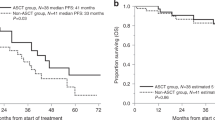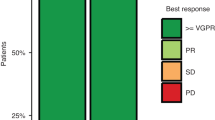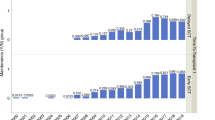Abstract
High-dose therapy (HDT) followed by autologous stem cell transplantation (ASCT) is the most common first-line treatment for patients with multiple myeloma (MM) under 65 years of age. A second ASCT at first relapse is frequently used but is challenged by the use of novel drugs. We retrospectively studied the outcome of second-line treatment in MM patients from the Nordic countries with relapse after first-line HDT and ASCT. Patients that underwent a second ASCT (n=111) were compared with patients re-treated with conventional cytotoxic drugs only (n=91) or with regimens including novel drugs (proteasome inhibitors and/or immunomodulatory drugs) (n=362) without a second ASCT. For patients receiving a second ASCT median overall survival was 4.0 years compared with 3.3 years (P<0.001) for the group treated with novel drugs and 2.5 years (P<0.001) for those receiving conventional cytotoxic drugs only. A second ASCT also resulted in a significantly longer second time to progression and a significantly longer time to next treatment. We conclude that, irrespective of the addition of novel drugs, MM patients in first relapse after ASCT still appear to benefit from a second ASCT. A second ASCT should be considered for all physically fit patients.
This is a preview of subscription content, access via your institution
Access options
Subscribe to this journal
Receive 12 print issues and online access
$259.00 per year
only $21.58 per issue
Buy this article
- Purchase on Springer Link
- Instant access to full article PDF
Prices may be subject to local taxes which are calculated during checkout


Similar content being viewed by others
References
Liwing J, Uttervall K, Lund J, Aldrin A, Blimark C, Carlson K et al. Improved survival in myeloma patients: starting to close in on the gap between elderly patients and a matched normal population. Br J Haematol 2014; 164: 684–693.
Kaufmann H, Ackermann J, Nosslinger T, Kromer E, Zojer N, Schreiber S et al. Absence of clonal chromosomal relationship between concomitant B-CLL and multiple myeloma—a report on two cases. Ann Hematol 2001; 80: 474–478.
Alici E, Bjorkstrand B, Treschow A, Aints A, Smith CI, Gahrton G et al. Long-term follow-up of gene-marked CD34+ cells after autologous stem cell transplantation for multiple myeloma. Cancer Gene Ther 2007; 14: 227–232.
Chanan-Khan AA, Giralt S . Importance of achieving a complete response in multiple myeloma, and the impact of novel agents. J Clin Oncol 2010; 28: 2612–2624.
Dingli D, Pacheco JM, Nowakowski GS, Kumar SK, Dispenzieri A, Hayman SR et al. Relationship between depth of response and outcome in multiple myeloma. J Clin Oncol 2007; 25: 4933–4937.
Coradini P, Cavo M, Lokhorst H, Martinelli G, Terragna C, Majolino I et al. Molecular remission after myeloablative allogeneic stem cell transplantation predicts a better relapse-free survival in patients with multiple myeloma. Blood 2003; 102: 1927–1929.
Corradini P, Voena C, Tarella C, Astolfi M, Ladetto M, Palumbo A et al. Molecular and clinical remissions in multiple myeloma: role of autologous and allogeneic transplantation of hematopoietic cells. J Clin Oncol 1999; 17: 208–215.
Gahrton G, Krishnan A . Allogeneic transplantation in multiple myeloma. Expert Rev Hematol 2014; 7: 79–90.
Attal M, Harousseau JL, Stoppa AM, Sotto JJ, Fuzibet JG, Rossi JF et al. A prospective, randomized trial of autologous bone marrow transplantation and chemotherapy in multiple myeloma. Intergroupe francais du myeloma. N Engl J Med 1996; 335: 91–97.
Child JA, Morgan GJ, Davies FE, Owen RG, Bell SE, Hawkins K et al. High-dose chemotherapy with hematopoietic stem-cell rescue for multiple myeloma. N Engl J Med 2003; 348: 1875–1883.
Atanackovic D, Schilling G . Second autologous transplant as salvage therapy in multiple myeloma. Br J Haematol 2013; 163: 565–572.
Uttervall K, Duru AD, Lund J, Liwing J, Gahrton G, Holmberg E et al. The use of novel drugs can effectively improve response, delay relapse and enhance overall survival in multiple myeloma patients with renal impairment. PLoS ONE 2014; 9: e101819.
Lund J, Uttervall K, Liwing J, Gahrton G, Alici E, Aschan J et al. Addition of thalidomide to melphalan and prednisone treatment prolongs survival in multiple myeloma–a retrospective population based study of 1162 patients. Eur J Haematol 2014; 92: 19–25.
Blade J, Samson D, Reece D, Apperlay J, Bjorkstrand B, Gahrton G et al. Criteria for evaluating disease response and progression in patients with multiple myeloma treated by high-dose therapy and haematopoietic stem cell transplantation. Myeloma subcommittee of the EBMT. European Group for Blood and Marrow Transplant. Br J Haematol 1998; 102: 1115–1123.
Garderet L, Iacobelli S, Moreau P, Dib M, Lafon I, Niederwieser D et al. Superiority of the triple combination of bortezomib-thalidomide-dexamethasone over the dual combination of thalidomide-dexamethasone in patients with multiple myeloma progressing or relapsing after autologous transplantation: the MMVAR/IFM 2005-04 randomized phase III trial from the chronic leukemia working party of the european group for blood and marrow transplantation. J Clin Oncol 2012; 30: 2475–2482.
Jimenez-Zepeda VH, Mikhael J, Winter A, Franke N, Masih-Khan E, Trudel S et al. Second autologous stem cell transplantation as salvage therapy for multiple myeloma: impact on progression-free and overall survival. Biol Blood Marrow Transplant 2012; 18: 773–779.
Lemieux E, Hulin C, Caillot D, Tardy S, Dorvaux V, Michel J et al. Autologous stem cell transplantation: an effective salvage therapy in multiple myeloma. Biol Blood Marrow Transplant 2013; 19: 445–449.
Ludwig H, Avet-Loiseau H, Blade J, Boccadoro M, Cavenagh J, Cavo M et al. European perspective on multiple myeloma treatment strategies: update following recent congresses. Oncologist 2012; 17: 592–606.
Cook G, Williams C, Brown JM, Cairns DA, Cavenagh J, Snowden JA et al. High-dose chemotherapy plus autologous stem-cell transplantation as consolidation therapy in patients with relapsed multiple myeloma after previous autologous stem-cell transplantation (NCRI Myeloma X Relapse (intensive trial)): a randomized, open-label, phase 3 trial. Lancet Oncol 2014; 15: 874–885.
Kumar SK, Therneau TM, Gertz MA, Lacy MQ, Dispenzieri A, Rajkumar SV et al. Clinical course of patients with relapsed multiple myeloma. Mayo Clin Proc 2004; 79: 867–874.
Author information
Authors and Affiliations
Corresponding author
Ethics declarations
Competing interests
The authors declare no conflict of interest.
Rights and permissions
About this article
Cite this article
Grövdal, M., Nahi, H., Gahrton, G. et al. Autologous stem cell transplantation versus novel drugs or conventional chemotherapy for patients with relapsed multiple myeloma after previous ASCT. Bone Marrow Transplant 50, 808–812 (2015). https://doi.org/10.1038/bmt.2015.39
Received:
Revised:
Accepted:
Published:
Issue Date:
DOI: https://doi.org/10.1038/bmt.2015.39
This article is cited by
-
Trends in utilization of stored cryopreserved autologous peripheral hematopoietic cells intended for a second (or beyond) autologous hematopoietic cell transplantation in patients with multiple myeloma: a single center experience
Bone Marrow Transplantation (2023)
-
Outcomes of salvage autologous stem cell transplantation for multiple myeloma with cytopenias and exposure to novel agents
Bone Marrow Transplantation (2017)
-
Cost analysis of a randomized stem cell mobilization study in multiple myeloma
Annals of Hematology (2016)



